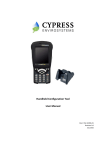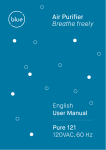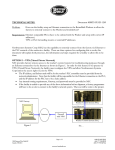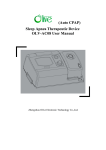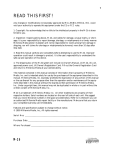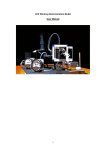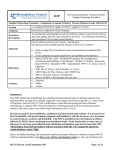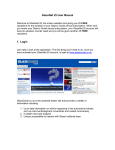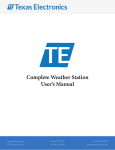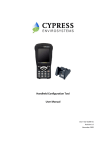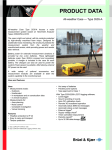Download horen Ventilated Caging - Lithgow Laboratory Services
Transcript
MANUAL MAXI-MISER CAGING SYSTEMS Page Introduction and air flow 1–2 Positive operation – product protection 3 Negative operation – people protection 4 Trouble shooting 5 How often to wash 6 Hepa filter / Blower module 7 Washing and Autoclaving 8 How to clean the Hepa filter / Blower module 9 Hybrid transition with optional exhaust fan 10-11 Autoclaving 12-13 Cage Sizes 14 Cage Materials 15 Air Exchange Rate 16 Thoren Caging Systems , Inc. 815 West Seventh St. P.O.Box 586 Hazleton, PA 18201-0586 Phone 570-455-5041 Fax 570-454-3500 Lithgow Laboratory Services 8414 W. Farm Rd #180-225 Las Vegas, NV 89131 Phone 702-413-0832 Fax 702-363-4981 1 INSTRUCTIONS MAXI-MISER CAGING SYSTEMS The Maxi-Miser Caging System can be operated wither positive or negative to your room, depending on our specific needs. The positive mode offers protection to the animal housed in the system. The negative mode offers protection to the investigator. DRAWING #1 The system is constructed so that the inner two tubes of the plenum carry supply (clean) air and the outer two tubes of the plenum carry exhaust (spent) air. Two magnehelics are provided on each rack to allow you to monitor the air pressure on both the supply air and the exhaust air relative to your room air. After placing the unit into the room in which it will be used, follow the instructions for the operating mode to meet your needs. (Either Positive or Negative pressures.) 1 2 Each shelf is divided into three separate compartments. The inner section is the supply ( clean ) duct. The outer two sections are the exhaust ( spent ) ducts. ( See drawing # 2 above ) In each cage position there is an orifice hole for the supply and an orifice hole for the exhaust air . ( See drawing #3 below D d D R A W IN G # 3 2 3 POSITIVE OPERATION - Product Protection 1. Zero the magnehelic gauges. (This must be done before the rack is running.) To do this, set the indicating needle exactly at the zero mark, using the zero adjust screw on the cover at the bottom of the magnehelic. (A small, straight blade screw driver works best.) Note: In the United States you will connect to a 110 volt, 60 hertz, single phase receptacle, capable of providing 4 amperes. In the United Kingdom and other European Countries, you will connect to a 240 volt, 50 hertz, single phase receptacle, capable of providing 4 amperes. 3. To adjust the supply air, adjust the damper for the supply air until the supply magnehelic reads .30 inches of water column. 4 To adjust the exhaust air adjust the damper for the exhaust air until the exhaust 3 4 NEGATIVE OPERATION -People Protection 1. Zero the magnehelic gauges. (This must be done before the rack is running.) To do this, set the indicating needle exactly at the zero mark, using the zero adjust screw on the cover at the bottom of the magnehelic. (A small, straight blade screw driver works best.) 2. Connect the rack to the air source. The air source may be the central Heating, Air Conditioning, and Ventilating System (HVAC)(Option 6), the HEPA Filter/Blower Module(Option 5), or the Hybrid Transition (Option 7). Make certain that the flexible hoses are securely fastened to the hose connections with a stainless steel hose clamp. Insert the electrical plug into the wall receptacle, the units %vill be running as soon as the electrical connection is made. 3. To adjust the supply air, adjust the damper for the supply air until the supply magnehelic reads .20 inches of water column. 4. To adjust the exhaust air, adjust the damper for the exhaust air until the exhaust magnehelic reads .30 inches of water column. 5. Allow the system to stabilize for twelve hours before introducing animals into the system. 4 5 TROUBLE SHOOTING 1. If you do not get sufficient static pressure on either the supply or the exhaust, check the following: a. Make sure that the black rubber plugs on the ends of all the shelves are in place. b. Be sure that the plates on the top and the bottom of the plenum are closed and clamped in place. c. Check to be sure that the HEPA filters are securely tightened down with the four jack screws, which seal the fan transition to the HEPA Filter gasket. d. Check to be sure that the HEPA Filter/Blower Module Cover Plates are securely fastened. e. Check the hoses for tears or air leaks. 2. Do not under any circumstances adjust the air static pressure by turning the adjustment screw on the magnehelic. 3. If your unit is equipped with automatic watering, make certain that your bedding is of sufficient size, so that the rodents cannot stuff it into the valves. Also check your valves to assure that they are adjusted to the proper flow rate. (Contact the automatic watering manufacturer for this information. Edstrom Industries -(414) 534-5181. SE Lab Group (513) 451-0530.) Thoren Caging Service# : (570) 455-5041 5 6 HOW OFTEN TO WASH? The question of how often to wash the Maxi-Miser Caging System is one that is often asked. The question of tear-down and thorough cleaning has become a matter of personal preference. The actual air supply and exhaust ducts are internal surfaces, which do not come in contact with ambient room air. These internal surfaces can be cultured on a weekly basis to determine the necessity for total tear down. The outer surfaces of the rack should be wiped down every time the cage is changed with a commercially available sterilant of your choice. When the cage has been removed from the system, the shelf area above that cage should be disinfected, as well as, the shelf area below the cage. Keep in mind that even stainless steel may be attacked by either strongly acidic or strongly alkaline compounds. 6 7 HEPA FILTER/BLOWER MODULE FREESTANDING, TOP MOUNTED, BOTTOM MOUNTED The HEPA Filter/Blower Module is the unit which contains HEPA Filters for both the supply air and the exhaust air. The service time of the filters depends on the cleanliness of the air source. When a filter becomes dirty, you will notice a pressure drop on your magnehelic gauge. You may compensate by opening the dampers on both the supply and the exhaust to maintain your static pressure, but we recommend that you replace your filters as soon as an uncorrectable pressure drop is detected. The Prefilters should be visually inspected on a weekly basis for dirt and clogging. By maintaining the Prefilters in good condition, you will substantially extend the life of your HEPA filters. HEPA Filters usually last five to six years, if the Prefilters have been maintained. The HEPA Filter/Blower Module is actually two completely separate unit. Each unit has a refilter, fan, and a HEPA Filter. The actual assembly drawings for each unit are attached. The Top Mounted and Bottom Mounted Supply Module is Drawing Number 3000-1. The Exhaust Module for these units is Drawing Number 3000-2. The Free Standing Module is Drawing Number 3002. The prefilters are accessible by removing the small prefilter Cover plate from the units and sliding the prefilter out. The prefilters in the Top Mounted and Bottom Mounted Modules are washable and autoclavable. The prefilters in the Free Standing Module are disposable. The HEPA Filters and the fans are accessible by removing the cover plates on both boxes. This is accomplished by removing the wing nuts (in the E.C. these are cap nuts) from the box. To remove the HEPA filters you must remove the cover plates, then loosen the four wing nuts which hold the fan in compression with the HEPA Filter. There are two wing nuts at the top of the filter and two at the bottom. When the four wing nuts are loose, slide the fan and fan transition (as one unit) out of the box and then remove the HEPA Filter. Reverse the procedure to reassemble, always making sure that the air flow direction and HEPA Filter direction are correct. (Air flow direction is away from the fan; HEPA Filter separators should be vertical.) Always change the prefilter when changing HEPA cartridges. We recommend washing the HEPA Filter/Blower Module when changing HEPA Filters. To wash the units you must remove the electrical box by removing the four screws that hold it in place, the prefilter, the HEPA Filter, and the fan, mounted on the fan transition. The Module then can be washed and autoclaved. 7 8 WASHING and AUTOCLAVING The Maxi-Miser Caging System can be washed and autoclaved with the exception of the Magnehelic Gauges, the fans, the prefilters ( in the free standing module and the Hybrid Supply Module), the HEPA filters, and the electrical components. I. To wash the Maxi-Miser Caging System unplug the system and remove the air source from the rack. 2. As with any caging system, the cages, cage covers, filter covers, water bottles and cardholders should be removed and washed as separate items. 3. 4. 5. The magnehelic Gauges are not washable and must be removed from the plenum. This is easily done by removing the nut and lock washer from the stem of the magnehelic, which holds it in place in the plenum. The supply magnehelic gauge and the exhaust magnehelic gauge have the stem fitting in different ports, you will not be able to put the gauges back improperly, as the stems will not line up with the holes in the plenum. Each shelf of the system is held in place with two red or gray handled clamps, these clamps must be opened and the shelf removed from the rack for thorough cleaning. The red shelf gasket and the black shelf plug should be removed from the shelf and can be washed separately. The shelf can now be placed in a washer to be sanitized. For ease of handling, a Shelf Wash Rack is available to handle nine shelves, nine gaskets, and nine plugs. The rack plenum has a clean-out plate on the bottom which is held in place with clamps, this plate must be opened to allow cleaning. Racks with free-standing HEPA Filter/Blower Modules or bottom-mounted HEPA Filter/Blower Modules will have a clean-out plate on the top as well, this must also be opened. The structural frame (consisting of the main air plenum, the ladder frame, the stringers, and the bottom frame with 8 9 How to wash the HEPA Filter/Blower Module: 1. Unplug the unit and disconnect the hoses which connect the unit to the rack. 2. Remove the two prefilters using the access panels on the unit. 3. Remove the main access panels from the module using the wing nuts (cap nuts in E.C.) 4. Loosen the four wing nuts that hold the fan transition in compression with the HEPA Filter in both the Supply Box and the Exhaust Box. 5. Unplug the fans and slide the fans, attached to the fan transitions, out of the boxes. 6. Remove the HEPA Filters from the units and discard of them properly. 7. Remove the electrical boxes from the modules by taking out the four screws that hold them in place. 8. You may now wash and autoclave the stainless steel enclosures. 9. When totally dry, reassemble the unit by reversing the steps listed above. Be sure that the HEPA Filters are placed in their proper operating position (check air flow direction and make sure that the proper side is up). Make sure that the four wing nuts seal the fan transition to the HEPA Filter are securely fastened. Reassemble the cover plates making sure that the proper plate is on the proper box. Test the filter seals with DOP. 9 10 HYBRID TRANSITION WITH OPTIONAL EXHAUST FAN The Hybrid Transition consists of a HEPA Filtered Supply Module, which is mounted on top of the rack, and a Transition, which allows you to connect the Supply Module to the Rack Supply and the Rack Exhaust to the central Heating, Air Conditioning, and Ventilating (HVAC) System. Both components of the Hybrid Transition are constructed of stainless steel and can be washed and autoclaved. The Hybrid Supply Module is shown in Drawing Number 3005-1. The optional Exhaust Fan Booster is shown in Drawing 3005-2. The HEPA Filtered Supply Module contains a prefilter, a fan, and a 12"x 12"x 11-1/2" HEPA Filter. The prefilter for the Supply Module is 12"x 12"x 2" and is located at the back of the unit. The prefilter is accessible by loosening the wing nut on the retainer bar and swinging the bar upward. The prefilter should be visually inspected every week for signs of clogging. By maintaining the prefilter in good condition, you will substantially extend the life of the HEPA Filter. The HEPA Filter and fan are accessible by removing the cover plate from the top of the module. To remove the HEPA Filter you must remove the cover plate, then remove the four wing nuts that hold the fan in compression with the HEPA Filter. Slide the fan, attached to the fan transition, away from the HEPA Filter and remove it from the module. Then slide the HEPA Filter away from the threaded rods which hold it in place and remove it from the module. Reverse the procedure to reassemble, always making sure that the air flow direction and HEPA Filter direction are correct. (Air flow is away from the fan; HEPA Filter separators should be vertical. Always change the prefilter when changing the HEPA cartridge. We recommend washing the HEPA Filtered Supply Module when changing the HEPA Filter. To wash the HEPA Filtered Supply Module 1. Unplug the unit from the wall receptacle and disconnect the hose which connects the unit to the transition. If you have the optional Exhaust Fan Booster or the alarm unplug these as well. 2. Remove the prefilter by swinging the retainer bar, which holds the prefilter in place, upward. 3. Remove the cover plate from the top of the unit by using the wing nuts. 4. Remove the four wing nuts from the threaded rod that holds the fan in compression with the HEPA Filter. 5. Unplug the fan and slide the fan, attached to the fan transition, out of the module. 10 11 6. Remove the HEPA Filter from the unit and discard of it properly. 7. Remove the electrical box, containing the circuit breakers, from the side of the module, by removing the four screws that secure it to the module. 8. You may now wash and autoclave the stainless steel box enclosure. 9. When totally dry, reassemble the unit by reversing the steps listed above. Be sure that the HEPA Filters are placed in their proper operating position (check air flow direction and make sure that the proper side is up). Make sure that the four wing nuts that seal the fan transition to the HEPA Filter are tightened. Test the filter seal with DOP. The transition which allows you to connect the Supply Module to the Rack Supply and the Exhaust to the central HVAC, can be removed from the rack by unlatching the two clamps, which hold it in place. If you have the optional Exhaust Fan Booster on your unit, you must remove this from the transition by using the four hex head bolts, which hold it in place. 11 12 AUTOCLAVING The Maxi-Miser Caging System can be autoclaved, each component of the system will be listed separately with instructions to help you to autoclave them most effectively. The Maxi-Miser Rack - is constructed from stainless steel and can be autoclaved with the exception of the magnehelic gauges. The magnehelic gauges can easily be removed by loosening the nut from the stem that holds the gauge to the plenum. To thoroughly clean the rack, the rack should be disassembled per the instructions on rack washing. The Air Sources (HEPA Filter/Blower Modules, Transitions and Hybrid Transitions) are constructed from stainless steel and can be autoclaved, but you must first remove the prefilters, the HEPA Filters, and the electrical components. Please follow the instructions for each particular piece of equipment for disassembly and cleaning. Cages - the standard Thoren cage is molded from high heat polycarbonate, which is autoclavable at 270° F. Polycarbonate (Lexan or Makrolon) has an autoclave life of approximately twenty cycles at 250° F. High Heat Polycarbonate (PPC or APEC) is autoclavable to 270° F and has an autoclavable life of approximately fifty cycles. Ultem or PSF have an autoclave life of hundreds of cycles at 270° F and are a better choice for facilities who must autoclave on a weekly or biweekly basis. To maximize the performance of your plastic cages it is best to use as short an autoclave cycle as possible. Cages to be autoclaved should not be subjected to mechanical loading during sterilization.(Mechanical Loading is stacking cage set-ups on top of one another so that the bottom cage has excessive weight on it.) The quality of the steam provided to the autoclave is important to the success of the autoclave cycle. Chemicals present in the steam (ie. water conditioning additives and boiler additives) can attack your plastic cages causing premature cage failure. Soap residue or chemical residue on cages which are autoclaved will also cause premature failure, as the autoclave accentuates the action of these incompatible materials on the cage and will cause cracking, crazing, and discoloration. The practice of placing bedding into the cages to be autoclaved can be detrimental to the cage, as some beddings, when autoclaved, release chemicals which attack the resin. The practice of marking cages with a marker can also be detrimental to cages, many markers contain solvent which chemically attacks resins. 12 13 Stainless Steel Cardholders - are constructed from stainless steel and can be autoclaved. Two types of cardholders are available either the hoof; for use with punched cards or a vertical/horizontal cardholder for use with 3"x 5" cards. Thoren also offers molded cardholders manufactured from the same resins as the cage. The plastic cardholders are attached to the cage and can be washed and autoclaved following the same protocol as the cages. Stainless Steel Cage Covers - are constructed from stainless steel wire bar and can be autoclaved with no problems. The Thoren Cage Covers have a few unique Bottles - are molded from glass, high heat polycarbonate, or PSF and can be autoclaved with the exception of the "drilled" glass bottle. If you want to use the "drilled" bottles and must autoclave, the polycarbonate or PSF bottles are the bottles to use. Thoren offers a variety of stoppers (neoprene or silicone), stainless steel caps, or plastic disposable caps for the bottles. The stoppers are washable and autoclavable, as are the stainless steel cap. The plastic disposable caps can be washed. but not autoclaved. features - every Thoren cover has a tag bar/handle so that the cover can be handled from the top without ever touching the underside of the cover. The Bottle Covers have a grommet which protects the stopper or cap from the rodent's gnawing. All Thoren Cage Covers have dimpled panels to allow thorough cleaning. 13 14 14 THOREN CAGING SYSTEMS, INC. 815 West Seventh Street P.O. Box 581 Hazleton, Pennsylvania, USA 18201 Air Exchange Rate Information Thoren Caging Systems, Inc. utilizes the Bruel and Kjaer 7620 to measure the decay of a tracer gas in the cage. We measure the concentration levels of sulfur hexafluoride tracer gas at various static pressures that the Maxi- Miser Caging System normally operates at. The graph above represents the actual readings from the BK 7620 and the air exchange rate in cage changes per hour at specific pressures in inches of water column. Average Cage Air Exchange Rate For Mouse # 9 Cage Cage Air Exchanges Per Hour 90 Magnehelic Gauge Readings 80 70 60 50 40 30 20 10 0 OFF OFF .10 .05 .15 .10 .20 .15 .25 .20 .30 .25 .35 .30 Recommended Setting .40 .35 .45 .40 .50 Supply .45 Exhaust


















































